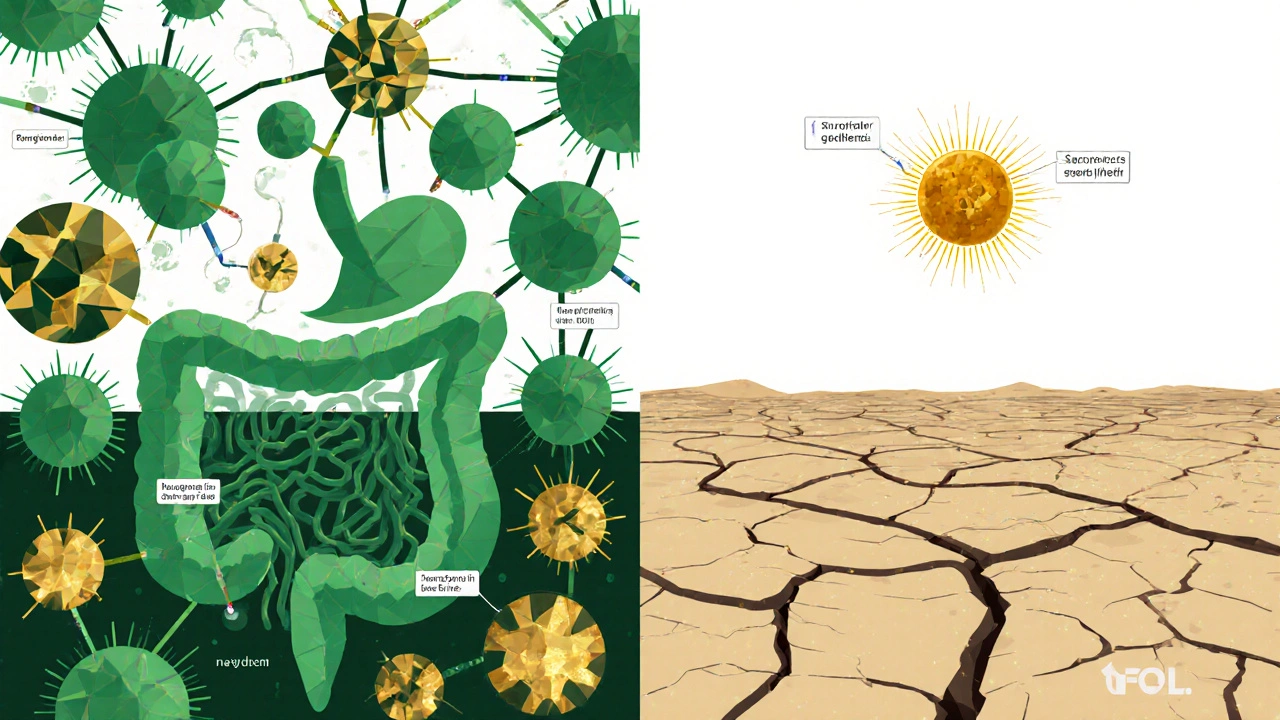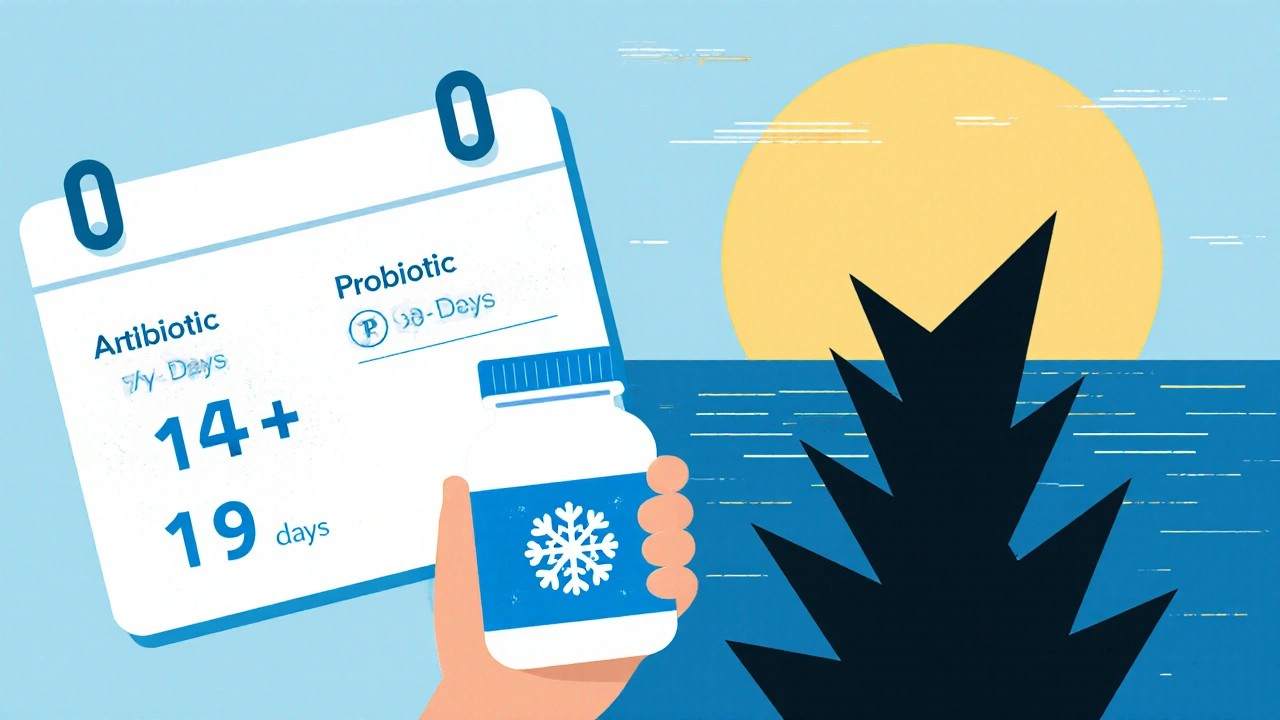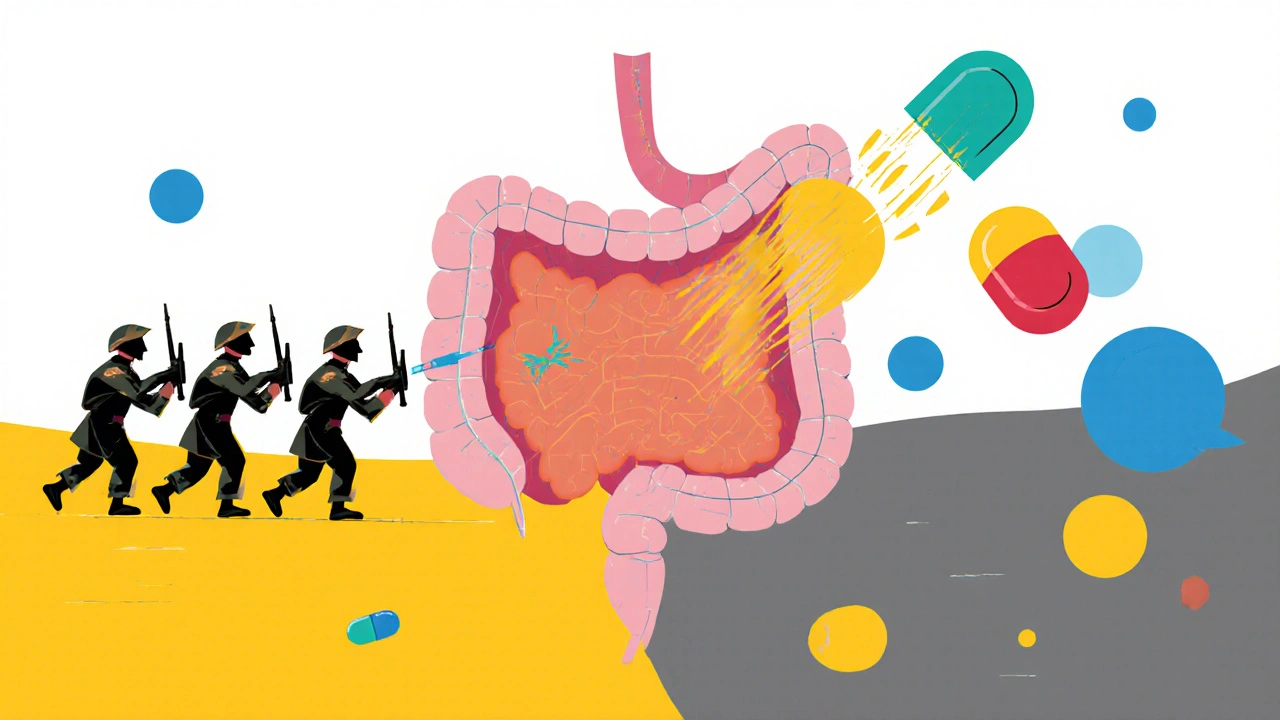Probiotic-Antibiotic Timing Calculator
Optimal Probiotic Timing
Follow the 2-hour rule to maximize benefits and prevent probiotics from being destroyed by antibiotics. Enter your antibiotic and probiotic dosing times below.
Enter your dosing times to see optimal timing
When you're on antibiotics, your gut knows it. You might feel bloated, get diarrhea, or just feel off - not because the infection is getting worse, but because the antibiotics are wiping out the good bacteria along with the bad. It’s like using a sledgehammer to swat a fly. That’s where probiotics come in. But here’s the catch: timing matters more than you think. Take them at the wrong time, and they might not help - or worse, they could slow down your gut’s natural recovery.
Why Probiotics Are Often Recommended with Antibiotics
Antibiotics don’t pick and choose. They kill bacteria - including the ones that keep your digestion smooth, your immune system sharp, and your mood balanced. Studies show that even a short course can leave your gut microbiome disrupted for months, sometimes up to two years. That’s why many doctors suggest adding probiotics during treatment. The goal isn’t to replace your native bacteria. It’s to give your gut a little backup. Certain strains, like Lactobacillus rhamnosus GG and Saccharomyces boulardii, have been shown in multiple trials to reduce the risk of antibiotic-associated diarrhea (AAD). A 2022 Cochrane review found that people taking these strains were 48% less likely to develop diarrhea compared to those who didn’t. That’s not a small win - especially if you’ve ever had a 14-day course of amoxicillin turn into a bathroom nightmare.The Big Controversy: Do Probiotics Help or Hurt Recovery?
Here’s where things get messy. In 2018, a landmark study in Nature Microbiology found something surprising: people who took probiotics after antibiotics took longer to get their original gut bacteria back. On average, it took 132 extra days for their microbiome to recover compared to those who didn’t take anything. That’s more than four months. That finding flipped the script. If probiotics delay your gut’s natural healing, are they doing more harm than good? Some experts, like Dr. Martin Blaser from Rutgers, argue yes. Others, like Dr. Elisa Marroquin from Texas Christian University, say the benefits - especially reducing diarrhea - outweigh the delay. The truth? It’s not all or nothing. A 2024 study in Frontiers in Microbiomes showed something new: while probiotics didn’t speed up microbiome recovery, they did reduce the spread of antibiotic resistance genes. That’s a big deal. Those genes can stick around in your gut and even get passed to other bacteria, making future infections harder to treat. So even if your gut doesn’t bounce back faster, you might be lowering your long-term risk.When to Take Probiotics: The 2-Hour Rule
If you’re going to take probiotics with antibiotics, timing is everything. Don’t swallow them together. Antibiotics are designed to kill bacteria - and they won’t care if the bacteria in your probiotic pill are supposed to help you. The best practice, backed by Harvard Medical School and the American Gastroenterological Association, is to take probiotics at least two hours before or after your antibiotic dose. This gives the antibiotic time to do its job without immediately wiping out the probiotic organisms. Most people who follow this rule report fewer side effects. A Drugs.com poll of nearly 2,000 users found that 42% took probiotics two hours after their antibiotic, and 38% took them two hours before. Only 20% took them at bedtime - which can work if your antibiotic is taken in the morning, but not if you’re on a nighttime dose.
Which Strains Actually Work?
Not all probiotics are created equal. There are over 500 commercial strains on the market. But only a handful have solid evidence for helping with antibiotic side effects.- Lactobacillus rhamnosus GG - Proven to reduce diarrhea risk by 26% more than multi-strain blends in one 2022 review.
- Saccharomyces boulardii - A yeast, not a bacteria, so antibiotics don’t kill it. Highly effective for preventing AAD, especially with broad-spectrum antibiotics like clindamycin.
- Lactobacillus plantarum 299v - In a 2023 ISAPP study, this strain preserved gut diversity 37% better than other common strains when taken 2 hours after antibiotics.
Dosage and Storage: What You Need to Know
Dose matters. Most studies use between 5 and 40 billion CFU (colony-forming units) per day. For most healthy adults, 10-20 billion CFU is enough. If you’re older, immunocompromised, or on a long or strong antibiotic course, 20-40 billion CFU may be better - but talk to your doctor first. Storage is just as important. Strains like Lactobacillus rhamnosus GG and Saccharomyces boulardii are sensitive to heat and moisture. Refrigerated products maintain 85-90% viability after 30 days. Shelf-stable versions? Only 65-70%. That means a bottle sitting on your kitchen counter might be half-dead by the time you finish your antibiotic course.What About After Antibiotics?
Don’t stop taking probiotics when your pills run out. Your gut needs time to rebuild. Most experts recommend continuing for at least one to two weeks after finishing antibiotics. For broad-spectrum antibiotics like vancomycin or ciprofloxacin, some doctors suggest extending it to four weeks. The 2024 John et al. study kept participants on probiotics for 28 days after antibiotics ended - and saw continued decline in resistance genes. That suggests the benefits don’t stop when the antibiotic does.
Who Should Avoid Probiotics?
Probiotics are safe for most people. But they’re not risk-free. If you’re:- Immunocompromised (from cancer treatment, HIV, or organ transplant)
- Have a central line or catheter
- Have a severe illness like pancreatitis
What Do Real People Say?
On Reddit’s r/Probiotics, 62% of 1,450 users reported fewer side effects when taking probiotics during antibiotics. One user wrote: “Saccharomyces boulardii saved me during my 14-day amoxicillin course. No diarrhea, no panic.” But 28% said they felt no difference. And 10% said their symptoms got worse. Healthline’s survey of 2,300 people found 54% had fewer GI issues with probiotics - but 17% got more bloating. Bottom line: It works for most, but not all. If you try it and feel worse, stop. Your body’s telling you something.The Bottom Line: Should You Take Probiotics with Antibiotics?
Here’s the practical takeaway:- If you’ve had antibiotic diarrhea before - take a probiotic.
- If you’re on a long or strong antibiotic - take one.
- If you’re healthy and just want to be safe - it’s probably fine.
- If you’re immunocompromised - talk to your doctor first.
Can I get probiotics from food instead of supplements while on antibiotics?
Yes, but it’s harder to get enough. Yogurt with live cultures, kefir, sauerkraut, and kimchi contain probiotics - but the strains and amounts vary widely. You’d need to eat large, consistent portions daily to match the dose in a supplement. For reliable results during antibiotic treatment, a targeted supplement is more effective.
Do probiotics interfere with antibiotics’ ability to fight infection?
No. There’s no evidence that probiotics reduce how well antibiotics work against the infection you’re treating. The concern is only about probiotics being killed by the antibiotic if taken too close together. Spacing them out by two hours avoids this.
How long should I take probiotics after finishing antibiotics?
At least one to two weeks. For broad-spectrum antibiotics like vancomycin or ciprofloxacin, extending to four weeks may help reduce the risk of lingering imbalances or resistance genes. There’s no harm in continuing longer if you feel better.
Are shelf-stable probiotics as good as refrigerated ones?
Not usually. Refrigerated strains like Lactobacillus rhamnosus GG and Saccharomyces boulardii stay viable at 85-90% after 30 days. Shelf-stable versions drop to 65-70%. That means you might not be getting the full dose you paid for. If you travel often, look for products with enteric coating or spore-forming strains like Bacillus coagulans.
Why do some doctors say not to take probiotics with antibiotics?
Because some research shows probiotics can delay the return of your native gut bacteria. A 2018 study found it took 132 days longer for the microbiome to recover in people who took probiotics. While they reduce diarrhea, they might slow natural healing. That’s why timing and strain choice matter - and why some doctors prefer waiting until after antibiotics to start.


joe balak
So probiotics are just bacteria in a pill and antibiotics kill bacteria... why does anyone think this makes sense? Just let your body sort it out.